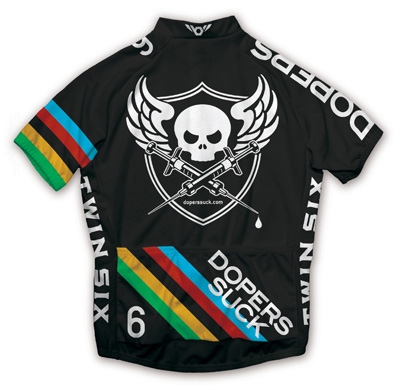Omertà
Noun
A code of silence amongst members of a criminal organization (especially the Mafia) that forbids divulging insider secrets.
– wiktionary.org
With the 2013 Tour de France over, and in light of the doping scandal surrounding Lance Armstrong – I took a dive into Tyler Hamilton’s book: The Secret Race. He tells all in excruciating detail of how professional cycling worked (and probably still works) on the inside.
As Americans, we seem to unanimously despise the use of performance enhancing drugs. We crave honesty so much that we’ll politicize the issue and enlist Congress,the FDA, or any government entity that will prosecute dopers and bring the truth to light.
The attitude has even permeated into cycling fashion:

Yet it has become clear to me that all professional sports are about gaming the system. The drug testing procedures and policies are open and published. Take the NBA for example. You may be tested up to 4 times per season. But after the 4th, you’re all clear – you can juice all you want. During testing, all an athlete needs to do is hire a doctor who knows how to work the system.
Doping in American Cycling
In Tyler’s book, he draws you in to the scene, explaining how the American cycling team was getting crushed in Europe – getting passed by European teams like they were riding motorcycles. They had to dope just to keep pace. He puts you in his shoes. You sensed that doping was inevitable if only to prevent further embarrassment. Their use of EPO seemed downright recreational, just give yourself a small shot into some fatty tissue.
Transfusions
Then the rabbit hole got deeper: cyclists doing autologous blood transfusions in a sly game to store your own blood and have your body to produce more, and then to re-inject extra later before a race, or in-between race stages. Let’s face it, at-home or in-hotel transfusions are not normal. Transfusions are normally reserved for medical patients who need a transfusion to survive. Clandestine blood-bag operations with anonymous delivery people add an extra layer of confusion that could lead to an athlete receiving a transfusion of someone else’s blood – which may have happened to Hamilton.
The Future – Paniagua?
This term, meaning “bread and water” (from Spanish pan y agua), is used to describe cyclists riding clean – like they’re just fueled by bread and water.
A friend of mine just assumes that all star athletes are juiced up to just below the point where they’ll get caught. Cycling is especially tainted. As Hamilton explains, the Festina affair in 1999 merely shifted the drug carrying responsibility from the team to the cyclists themselves. Teams and riders claimed they were riding paniagua, but Operación Puerto in 2006 showed that things had just gotten more secret and sophisticated.
We can thank Tyler Hamilton (and to some extent Lance Armstrong) for coming clean. Tyler telling all gives insight into the lengths riders would go to get their fix. He broke the omertà so that the sport can start anew. Now teams, besides taking a stance against doping, are sharing their power data. Even without obtaining rider’s power data, it can inferred through well known climbs like L’Alpe d’Huez.
The entire sport including riders, team directors, and doctors, needs to prove that it can ride clean. Some argue that it will make the sport less exciting, but I think it will do the opposite. No longer will you have super-human multi-day efforts. A rider that dominates one day will be spent, opening the door for “fresh” riders to overtake them the next day. I don’t want to see a race where the yellow jersey only trades riders during the first week. I’d like to see it be contested right up until the end.
So is everything clean? Probably not, but it’s heading in the right direction. The peloton is slowing down towards mere mortal speeds. But as an insider, Tyler Hamilton has heard rumors that small autologous blood transfusions are still happening – and he believes it.
While current pro cyclists may not be using drugs – storing blood for a performance boost later is not normal. Transfusions should be used for saving lives, not underhanded winning.
Leave a Reply